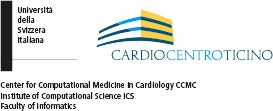Simone Pezzuto

Faculty of Informatics
Via Giuseppe Buffi 13
6900 Lugano
Switzerland
Simone Pezzuto
CCMC Group LeaderSimone Pezzuto is Group Leader at the Center for Computational Medicine in Cardiology (CCMC). The center of the research activities of Dr. Pezzuto lies at the interdisciplinary intersection between applied mathematics and cardiac physiology. In the spirit of the CCMC vision, Dr. Pezzuto fosters a tight collaboration with the clinical partners to translate mathematical modeling of the heart into clinical applications. While being a numerical analyst by education, Dr. Pezzuto collaborates on a daily basis with clinical cardiac electrophysiologists at addressing, by means of computer models, questions of clinical interest.
The group of Dr. Pezzuto, currently consisting of 1 postdoc (Dr. Ali Gharaviri) and 1 PhD student (Lia Gander), has the objective to develop novel numerical methods to tackle problems of clinical relevance, such as inverse problems and parameter identification, uncertainty quantification, and efficient simulation of both cardiac electrophysiology and mechanics.
Patient-Specific modeling

Patient-specific modeling in cardiac electrophysiology is based on sophisticated mathematical models which require special care in their numerical solution and parametrization. Given the increasing availability of patient data, from the standard 12-lead electrocardiogram to minimally invasive, high-density catheter mapping, we employ modern numerical algorithms to assimilate such data into the model for further individualization and, ultimately, improved therapeutic intervention. Amongst our recent achievements, we have been able to identify sites of earliest ventricular activation from the 12-lead ECG and to reconstruct the fiber architecture and conduction velocity from contact-mapping recordings.
Uncertainty Quantification
 In view of clinical applications, and given its importance, our group has recently started to include uncertainty quantification (UQ) into our electrophysiology models. The strategy we pursued was to combine existing models for cardiac electrophysiology to accelerate the standard Monte Carlo procedure (multifidelity approach). Incidentally, we have also developed a method for sampling random fields on general and possibly complex geometries, such as the heart anatomy.
In view of clinical applications, and given its importance, our group has recently started to include uncertainty quantification (UQ) into our electrophysiology models. The strategy we pursued was to combine existing models for cardiac electrophysiology to accelerate the standard Monte Carlo procedure (multifidelity approach). Incidentally, we have also developed a method for sampling random fields on general and possibly complex geometries, such as the heart anatomy.
Academic Career
Current position
- Group Leader, Center for Computational Medicine in Cardiology, Institute of Computational Science, USI
- 11-2019 - present
Past positions
- Postdoctoral researcher, Center for Computational Medicine in Cardiology, Institute of Computational Science, USI
- 01-2015 - 10-2019
- Postdoctoral researcher, Simula Research Laboratory
- 08-2013 - 12-2014
- Research assistant, Politecnico di Milano
- 01-2013 - 08-2013
Education
- Ph.D. in Mathematics, MOX, Politecnico di Milano
- 01-2010 - 05-2013 (XXV ciclo)
Thesis: Mechanics of the Heart: Constitutive Issues and Numerical Experiments, advisor Prof. D.Ambrosi - Visiting student, Cardiac Mechanics Research Group, UCSD
- 07-2011 - 12-2011
- Master's Degree in Mathematical Engineering, Politecnico di Milano
- 04-2008 - 12-2009
Thesis: Space-time adaptivity for non-linear reaction-diffusion systems with application to electrocardiology (pdf in italian), advisors Prof. F.Nobile and S.Perotto. - Bachelor in Mathematical Engineering, Politecnico di Milano
- 09-2004 - 03-2008
Thesis: Analytical estimates of principal frequency of polygonal membranes (pdf in italian), advisor Prof. M. Bramanti.




